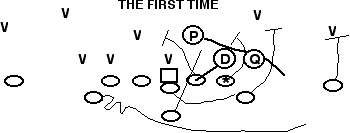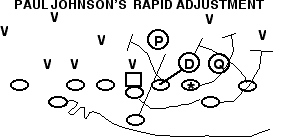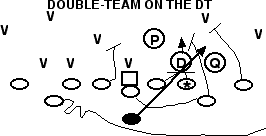Below is an excerpt from comments mailed to him from coaches across the country. His own analysis of the Navy/ND game is about as an outstanding explanation of making blocking adjustments in the spread option as you're likely to see anywhere. Props to Hugh and his great site, www.coachwyatt.com.
- *********** It was Notre Dame 28, Navy 28, with 45 seconds left. And even Notre Dame's NBC announcers up in the press box expressed mild criticism when Jolly Cholly, faced with a fourth-and-eight at the Navy 25, passed up the field goal and went for it.
- Later Weis said something about the wind. What - your chances of making a fourth-and-eight were better than your chances of making a 42-yard field goal?
- He might have tried a fake field goal, but he'd already tried that back in the first quarter, and it didn't work. Maybe that was because it was fourth and 15! WTF??? Fourth and 15, and he's faking it? Analyst Pat Haden did criticize that call. Come to think of it, the director probably told Haden that there'd be no more criticism of Coach Weis, which would account for the mildness of his comment on Weis' fourth-quarter idiocy.
- *********** Give Pat Haden credit. He's essentially on the ND payroll as an announcer on NBC, the Official Notre Dame Mouthpiece, but he can still be fair. When Notre Dame's final incompletion - and an apparent Navy win - was instead ruled pass interference against Navy, giving ND a do-over, the camera showed us a very unhappy Paul Johnson, and Haden commented, "I think he has a right to be upset."
- *********** After looking at the video of the Navy-Notre Dame game... What a job Paul Johnson did, closing down into a Double-Slot so that his nasty-split ends could crack down on ND's fast-flowing inside LBers. And Notre Dame "reacted" by not reacting at all - moving their corners in, of course, but keeping them at 6 yards depth and their safeties at seven. After Navy ate their lunch a few times with toss sweeps and option pitches, they got smart and moved them up. And then, to win the game, Johnson hit them with the wingback on a wheel!
- But then, nobody said Charlie Weis was a defensive genius. He is, as we all know (and as Notre Dame's stellar offensive performance has borne out this year), an offensive genius. (By the way, anybody know how New England's doing without him?)
- One of the beauties of running the same offense as long as Navy's Paul Johnson has is that he's seen just about anything a defense can do to him, and he's got answers. It took him oh, maybe two plays to recognize what Notre Dame was doing Saturday, and make the necessary adjustments.

- With a bye week to prepare for Navy, here's the scheme that ND came up with to defense Navy's triple option:
Slanting Def tackle has dive (D), outside LBer has QB (Q) and inside LBer has pitch (P). The first time Navy ran the play, the inside LBer was flowing so fast to the outside that the playside tackle (*) couldn't get to him, and the pitch man was tackled for a loss. On the next play, Navy turned the ball over.
 And the very next offensive series, Navy came out in what we would call "Slot" or "Double Slot", with their ends in a "nasty split" of 3-5 yards. Notre Dame made no adjustment, other than to move their corners in (but still at 6 yards' depth). They left their OLBs in the "nasty" gap, vulnerable to a down block by the Navy ends.
And the very next offensive series, Navy came out in what we would call "Slot" or "Double Slot", with their ends in a "nasty split" of 3-5 yards. Notre Dame made no adjustment, other than to move their corners in (but still at 6 yards' depth). They left their OLBs in the "nasty" gap, vulnerable to a down block by the Navy ends.- Now, the man responsible for the pitch, the fast-flowing inside LBer, was blocked by the Navy end. The Navy tackle now released upfield for the safety, whom (this being NCAA rules) he was able to block at the knees. And the playside wingback, after a very slight pause - just long enough to freeze the OLBer so the tackle could pull across his face, arc-blocked on the corner.
- For Navy: Problem solved. For ND: Two weeks of preparation out the window.
 Haw, haw, haw! This, a flexbone version of an outside veer, was my favorite, because Navy proved once again that two "average," undersized Navy linemen working together can knock the ass off a Notre Dame blue-chipper. Knowing that the Notre Dame DT would be slanting to stuff the fullback dive, the Navy playside guard and tackle put the wood to him with a classic double-team. They mashed the Notre Dame tackles, actually hitting them with their shoulder pads (if you can believe that anyone in this modern age would still use such outmoded tactics), and driving them back into the paths of the scraping playside LBers. Hmmm. Anybody know anyone else who preaches doing that with their double-teams?
Haw, haw, haw! This, a flexbone version of an outside veer, was my favorite, because Navy proved once again that two "average," undersized Navy linemen working together can knock the ass off a Notre Dame blue-chipper. Knowing that the Notre Dame DT would be slanting to stuff the fullback dive, the Navy playside guard and tackle put the wood to him with a classic double-team. They mashed the Notre Dame tackles, actually hitting them with their shoulder pads (if you can believe that anyone in this modern age would still use such outmoded tactics), and driving them back into the paths of the scraping playside LBers. Hmmm. Anybody know anyone else who preaches doing that with their double-teams?- The QB appeared to read the unblocked OLB, who had been trained not to leave his main responsibility - the QB. So the QB's read was always "give." The playside corner, who as the game went on began sneaking closer to the line, was no factor, either, because he had to come up to take the pitch.
 One of the reasons people hate to play Navy is that Navy blocks low. Legal, but low. Not very enjoyable for defensive linemen used to standing up and dancing with opponents on passing teams. As an example of what Notre Dame's nose man had to deal with on plays going to his left (Navy's right), here are three different techniques he had to face. On the left, the center fires low to playside and the guard comes in second - not a chop block, because the first hit is low; in the middle, as part of the scoop technique, the center slips past the nose and up onto the backside backer, while the backside guard takes the nose man low. Again, not a chop block because the Navy center is making a bona fide effort to escape the nose and is not "engaging" him. Finally, the center reaches the nose with a high drive block, while the guard steps at the nose then fires up on the backer.
One of the reasons people hate to play Navy is that Navy blocks low. Legal, but low. Not very enjoyable for defensive linemen used to standing up and dancing with opponents on passing teams. As an example of what Notre Dame's nose man had to deal with on plays going to his left (Navy's right), here are three different techniques he had to face. On the left, the center fires low to playside and the guard comes in second - not a chop block, because the first hit is low; in the middle, as part of the scoop technique, the center slips past the nose and up onto the backside backer, while the backside guard takes the nose man low. Again, not a chop block because the Navy center is making a bona fide effort to escape the nose and is not "engaging" him. Finally, the center reaches the nose with a high drive block, while the guard steps at the nose then fires up on the backer. - *********** The irony of the Navy win over ND was that Navy's final touchdown - and winning two-point conversion - both came on passes. And both were to Reggie Campbell, who at 5-6, 160 pounds is way too small to play major college football. Except in Paul Johnson's offense.
- -- Excerpt from www.coachwyatt.com
No comments:
Post a Comment